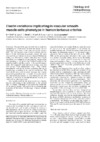Identificador persistente para citar o vincular este elemento:
https://accedacris.ulpgc.es/jspui/handle/10553/76897
| Campo DC | Valor | idioma |
|---|---|---|
| dc.contributor.author | Ortiz, P. P. | en_US |
| dc.contributor.author | Sarrat, R. | en_US |
| dc.contributor.author | Daret, D. | en_US |
| dc.contributor.author | Whyte, J. | en_US |
| dc.contributor.author | Torres, A. | en_US |
| dc.contributor.author | Daniel-Lamazière, J. M. | en_US |
| dc.date.accessioned | 2020-12-22T09:23:47Z | - |
| dc.date.available | 2020-12-22T09:23:47Z | - |
| dc.date.issued | 2000 | en_US |
| dc.identifier.issn | 0213-3911 | en_US |
| dc.identifier.other | WoS | - |
| dc.identifier.uri | https://accedacris.ulpgc.es/handle/10553/76897 | - |
| dc.description.abstract | The aim of the present work was to study the morphological implications between the elastin and the phenotypic expression of the vascular smooth muscle cells. For this purpose, sixty human tortuous arteries from different territories have been studied. We have measured the morphometric indexes Intimal Thickening Index and Elastolyse Index and they have been quantified with computer system analysis, image-colour corresponding to the orcein and Verhoeff reactions for detecting elastin and the alpha-actin in the smooth muscle cells. We compared both territorial arteries from the cranial and from abdominal origin. The elastin concentration was similar in both territories, but not its morphology according to its spatial distribution. We have observed a relationship between the elastin structural organisation from the media of arteries and of the internal elastic lamina in these territories and the variation of reactivity to the smooth muscle cr-actin as a marker of the phenotypic state.Our results confirm the hypothesis that elastin, besides intervening in the architecture of the arterial wall, is a factor implicated in the phenotypic variability of the smooth muscle cells and in the development and evolution of the intimal thickenings in human atherosclerosis. | en_US |
| dc.language | eng | en_US |
| dc.relation.ispartof | Histology and Histopathology | en_US |
| dc.source | Histology and Histopathology [ISSN 0213-3911], v. 15 (1), p. 95-100, (Enero 2000) | en_US |
| dc.subject | 240703 Morfología celular | en_US |
| dc.subject.other | Elastin | en_US |
| dc.subject.other | Vascular Smooth Muscle Cells | en_US |
| dc.subject.other | Arterial Thickening | en_US |
| dc.subject.other | Arterial Tortuosity | en_US |
| dc.title | Elastin variations implicating in vascular smooth muscle cells phenotype in human tortuous arteries | en_US |
| dc.type | info:eu-repo/semantics/Article | en_US |
| dc.type | Article | en_US |
| dc.identifier.doi | 10.14670/HH-15.95 | en_US |
| dc.identifier.scopus | 0033972229 | - |
| dc.identifier.isi | 000084954900012 | - |
| dc.contributor.authorscopusid | 7102415963 | - |
| dc.contributor.authorscopusid | 7004230388 | - |
| dc.contributor.authorscopusid | 6603867076 | - |
| dc.contributor.authorscopusid | 7102601057 | - |
| dc.contributor.authorscopusid | 57198471385 | - |
| dc.contributor.authorscopusid | 6701668898 | - |
| dc.description.lastpage | 100 | en_US |
| dc.identifier.issue | 1 | - |
| dc.description.firstpage | 95 | en_US |
| dc.relation.volume | 15 | en_US |
| dc.investigacion | Ciencias de la Salud | en_US |
| dc.type2 | Artículo | en_US |
| dc.contributor.daisngid | 9346465 | - |
| dc.contributor.daisngid | 1560639 | - |
| dc.contributor.daisngid | 798486 | - |
| dc.contributor.daisngid | 5107418 | - |
| dc.contributor.daisngid | 12520484 | - |
| dc.contributor.daisngid | 763294 | - |
| dc.description.numberofpages | 6 | en_US |
| dc.utils.revision | Sí | en_US |
| dc.contributor.wosstandard | WOS:Ortiz, PP | - |
| dc.contributor.wosstandard | WOS:Sarrat, R | - |
| dc.contributor.wosstandard | WOS:Daret, D | - |
| dc.contributor.wosstandard | WOS:Whyte, J | - |
| dc.contributor.wosstandard | WOS:Torres, A | - |
| dc.contributor.wosstandard | WOS:Lamaziere, JMD | - |
| dc.date.coverdate | Enero 2000 | en_US |
| dc.identifier.ulpgc | Sí | en_US |
| dc.description.jcr | 1,553 | |
| dc.description.jcrq | Q2 | |
| dc.description.scie | SCIE | |
| item.fulltext | Con texto completo | - |
| item.grantfulltext | open | - |
| Colección: | Artículos | |
Citas SCOPUSTM
5
actualizado el 08-jun-2025
Citas de WEB OF SCIENCETM
Citations
4
actualizado el 25-feb-2024
Visitas
136
actualizado el 15-ene-2026
Descargas
53
actualizado el 15-ene-2026
Google ScholarTM
Verifica
Altmetric
Comparte
Exporta metadatos
Los elementos en ULPGC accedaCRIS están protegidos por derechos de autor con todos los derechos reservados, a menos que se indique lo contrario.
